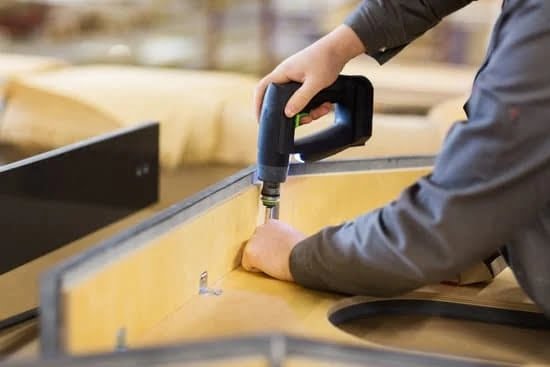Welcome to the world of woodworks projects. Whether you’re a seasoned DIY enthusiast or just embarking on your woodworking journey, this blog post is here to guide you through every step of creating something extraordinary with wood. Woodworking has become increasingly popular among individuals looking for a fulfilling hobby that combines creativity, craftsmanship, and practicality. So, let’s dive in and discover the exciting realm of woodworks projects together.
In this comprehensive guide, we will explore everything you need to know about woodworks projects. From choosing the perfect wood for your project to mastering essential woodworking techniques, planning your project from design to execution, and enhancing it with finishes and sealants – we cover it all. We will also walk you through building your first woodworks project and provide tips for displaying and sharing your creations.
Why has woodworking gained such popularity? Perhaps it’s because working with wood allows us to unleash our creativity while also providing a sense of accomplishment as we transform raw materials into functional and beautiful pieces. Moreover, woodworking offers an opportunity to disconnect from our fast-paced digital lives and connect with nature’s most versatile material.
Throughout this article, we aim to instill confidence in beginners while inspiring seasoned woodworkers with advanced techniques and unique inspirations. So dust off those tools, roll up your sleeves, and let’s embark on an exciting journey into the captivating world of woodworks projects.
Choosing the Perfect Wood for Your Project
Wood selection is a crucial aspect of any woodworks project. Choosing the right type of wood will not only affect the aesthetics of your project but also its durability and cost. With so many options available, it can be overwhelming to decide which wood is best suited for your project. In this section, we will explore the different types of wood suitable for woodworks projects and discuss factors to consider when selecting the perfect wood.
There are three main categories of wood commonly used in woodworking projects: hardwood, softwood, and plywood. Hardwood, such as oak or mahogany, is known for its strength and durability. It is often used for furniture making or intricate woodworking projects due to its beautiful grain patterns. Softwood, such as pine or cedar, is more affordable and easier to work with than hardwood. It is commonly used for construction projects or outdoor furniture due to its natural resistance to decay.
When selecting the perfect wood for your project, there are several factors to consider. First and foremost, you need to assess the durability requirements of your project. Will it be exposed to moisture or excessive wear? If so, it’s essential to choose a wood that can withstand these conditions.
Additionally, aesthetics play a significant role in wood selection. Consider the color and grain pattern that will complement your desired look. Lastly, budget considerations are necessary as certain types of wood can be quite costly.
Sourcing high-quality wood is vital for achieving satisfactory results in your woodworks project. Local lumberyards and specialty stores are excellent places to find a wide variety of woods suitable for different projects. They often offer guidance on choosing the right type of wood based on your project requirements. Online marketplaces also provide access to a vast selection of woods from around the world.
To summarize:
- Types of Wood: Hardwood (e.g., oak), softwood (e.g., pine), or plywood.
- Factors For Consideration: Durability, aesthetics, and cost.
- Sourcing Wood: Local lumberyards, specialty stores, or online marketplaces.
By carefully choosing the perfect wood for your project, you can ensure that your woodworks experience is rewarding and yields exceptional results.
Essential Tools and Equipment for Woodworks Projects
Woodworking is a craft that requires the use of various tools and equipment to create beautiful and functional pieces. Whether you are a beginner or an experienced woodworker, having the right tools on hand is essential for achieving professional results. In this section, we will discuss the essential tools and equipment that every woodworker should have in their arsenal.
Cutting Tools
One of the most important categories of tools in woodworking projects is cutting tools. These tools help you shape and cut the wood to your desired size and shape. Some essential cutting tools include:
- Circular Saw: This versatile power tool is perfect for making straight cuts, crosscuts, bevel cuts, and more.
- Jigsaw: Ideal for cutting curves and irregular shapes into wood.
- Hand Saw: A classic tool used for cutting smaller pieces or making precise cuts.
Measuring and Marking Tools
Accurate measurements are crucial in woodworking projects to ensure proper fit and alignment. Here are some must-have measuring and marking tools:
- Tape Measure: Necessary for taking length measurements accurately.
- Combination Square: A multifunctional tool used for measuring angles, checking squareness, and marking straight lines.
- Marking Gauge: Ideal for marking parallel lines or mortise depths accurately.
Joinery Tools
Joinery refers to the process of connecting two or more pieces of wood together securely. Some common joinery tools include:
- Chisels: Used for removing small amounts of wood or creating intricate details.
- Mallet: Needed to strike chisels or other striking tools while preserving their handles.
- Router: Enables you to create decorative edges, grooves, dadoes, and mortises.
Finishing Tools
After completing the construction of your project, finishing tools come into play to give it a polished look. These tools include:
- Sandpaper: Essential for smoothing the wood and removing any imperfections.
- Paintbrushes: Used for applying finishes, stains, or paint to your project.
- Woodworking Clamps: Necessary for holding pieces together firmly during gluing or drying.
It’s important to note that investing in high-quality tools will enhance your woodworking experience and make your projects more enjoyable. However, if you are on a budget, there are also budget-friendly alternatives available that can still deliver satisfactory results. Additionally, it’s crucial to prioritize safety when working with tools and always wear appropriate protective gear.
With the right tools at your disposal, you’ll be able to tackle various woodworking projects with confidence and achieve professional-looking results.
Planning Your Woodworks Project
Proper planning is essential for a successful woodworks project. It not only helps you visualize the end result but also ensures that you have a clear roadmap to follow during the execution phase. In this section, we will guide you through the process of planning your woodworks project, from design to execution.
Visualizing and Designing Your Project
Before diving into any woodworking project, it is important to have a clear vision of what you want to create. Spend some time brainstorming and sketching out ideas for your project. Consider the purpose of the piece, its dimensions, and any specific features or details you want to include.
Once you have a rough idea in mind, create a detailed design plan. This can be done using drafting software, online design tools, or simply drawing by hand. Include accurate measurements, cutting lists, and sketches of each component. This will act as your blueprint throughout the project and help ensure that everything fits together perfectly.
Breaking Down Complex Projects
Complex woodworking projects can sometimes feel overwhelming. To make them more manageable, break them down into smaller tasks. Start by identifying the main components or sections of your project. Then, further break down each component into individual steps.
By breaking down the project into smaller tasks, you can tackle each one systematically while keeping an overview of the bigger picture. This approach also allows for better time management and helps prevent mistakes or miscalculations along the way.
Measure Twice, Cut Once
One crucial aspect of planning a woodworks project is accuracy in measurements. Remember the old carpenter’s adage: “Measure twice, cut once.” Take extra care when measuring your materials to ensure precise cuts and minimize wastage. Use quality measuring tools such as tape measures and squares.
It’s also important to keep in mind that wood can expand or contract due to changes in temperature and humidity. Consider these factors when determining your measurements, especially for pieces that need to fit together snugly.
By following these planning guidelines, you will be well-prepared to move forward with confidence in your woodworks project. Remember to take your time during the planning phase – it will save you valuable time and headaches later on. In the next section, we will explore basic woodworking techniques that every aspiring woodworker should master.
Mastering Basic Woodworking Techniques
Woodworking is a skill that requires mastering various techniques to achieve precise and professional results. Whether you are a beginner or have some experience in woodworking, it is essential to have a strong foundation in basic woodworking techniques. This section will introduce you to fundamental woodworking techniques, provide step-by-step instructions for mastering each technique, and offer common mistakes to avoid and pro tips for achieving exceptional results.
- Cutting: Accurate cutting is crucial for any woodworks project. To master this technique, start by choosing the right saw for the job. A circular saw or a miter saw is ideal for straight cuts, while a coping saw or a jigsaw can be used for curved cuts. Use a marking tool such as a pencil or marking knife to create precision guidelines before cutting.
- Drilling: Drilling holes in wood is another essential technique in woodworking. Start with selecting the appropriate drill bit size based on your project requirements. It is important to maintain control while drilling by securing the workpiece firmly and using steady pressure without forcing it. Remember to adjust the depth collar on your drill according to the desired hole depth.
- Sanding: Achieving smooth and polished wood surfaces requires effective sanding techniques. Begin by using coarse-grit sandpaper to remove any rough surfaces or imperfections from the wood. Gradually progress to finer grits until you achieve your desired smoothness. Always sand with the grain of the wood and be mindful of applying even pressure.
- Joinery Techniques: Mastering joinery techniques allows you to create strong connections between pieces of wood. Some common joinery techniques include butt joints, dado joints, dovetail joints, and mortise-and-tenon joints. Each technique has its advantages depending on the strength required and aesthetics of your project.
By practicing these basic woodworking techniques, you will gain confidence and improve your skills as a woodworker. Remember to prioritize safety by wearing protective gear such as safety glasses and gloves, and always follow proper handling and usage guidelines for your tools. With patience and practice, you will be well on your way to creating extraordinary woodworks projects.
Building Your First Woodworks Project
Building your first woodworks project can be an exciting and rewarding experience. Whether you’re looking to create a simple wooden shelf or a picture frame, this beginner’s guide will walk you through the process step by step. By following these detailed instructions, you’ll gain confidence in your woodworking skills and have a finished project that you can proudly display in no time.
The first stage in building your woodworks project is material preparation. Start by selecting the type of wood that best suits your project’s needs. Consider factors such as durability, aesthetics, and cost when making your choice. Once you’ve acquired the wood, make sure to measure and cut it according to your design specifications. Accurate measurements are crucial for ensuring that all the pieces fit together properly.
After cutting your wood, it’s time to assemble the pieces. Depending on your project, this may involve using screws, nails, or glue to secure everything together. Follow the instructions carefully and take your time during this stage to ensure that each joint is sturdy and secure.
Once everything is assembled, it’s time to add the finishing touches to your woodworks project. Sanding is an essential step that helps smooth out any rough edges or surfaces on the wood. This not only enhances the appearance of your project but also makes it safer to handle. After sanding, consider applying a finish or stain to protect the wood and enhance its natural beauty.
As a beginner, it’s common to encounter challenges or make mistakes along the way. Don’t become discouraged if something doesn’t turn out exactly as planned. Woodworking is a skill that takes practice and patience to master. Instead, view any setbacks as learning opportunities and use them to improve your future projects.
By following this beginner’s guide and embracing the process of building your first woodworks project, you’ll develop valuable skills while creating something unique with your own hands. So gather your tools, select a project that inspires you, and dive into the world of woodworking with confidence.
Enhancing Your Woodworks Project
Finishes, stains, and sealants are essential components of any woodworks project as they not only enhance the appearance of the finished piece but also provide protection against environmental factors such as moisture and UV rays. In this section, we will explore the importance of choosing the right finish for your woodworks project and provide a step-by-step guide for applying finishes, stains, and sealants.
Choosing the right finish is crucial as it can significantly impact the overall look and durability of your woodworks project. There are various types of finishes available, including oil-based, water-based, and varnish. Each type has its own pros and cons, so it’s important to consider factors such as ease of application, drying time, odor, sheen level, and maintenance requirements when making your selection.
Oil-based finishes are known for their durability and ability to bring out the natural beauty of wood. They provide a rich and deep color that can enhance the grain patterns. On the other hand, water-based finishes are popular for their quick drying time and low odor. They offer excellent protection against UV rays but may require more coats for a desired finish. Varnish finishes offer superior protection against moisture damage but may have a longer drying time.
Once you have chosen the appropriate finish for your project, it’s time to apply it to your woodwork. Before starting the application process, ensure that your wood surface is clean and free from dust or debris. Use sandpaper or steel wool to smooth out any imperfections on the surface before proceeding with the finishing process.
Apply thin layers of finish using a bristle brush or a cotton cloth in long even strokes following the direction of the wood grain. Allow each layer to dry completely before applying another coat. Sanding between coats can help achieve a smoother finish. After applying multiple coats, allow ample drying time as per manufacturer’s instructions before moving on to staining or sealing if desired.
Stains can be used to add color and depth to your woodworks project. They come in various shades and can be used alone or in combination with a finish. Before applying the stain, it’s recommended to test it on a small inconspicuous area of the project or on a scrap piece of the same wood to ensure that you achieve the desired shade.
Sealants are applied as a final layer of protection for your woodwork, providing resistance against water, heat, and scratches. There are different types of sealants available, such as polyurethane and lacquer, each offering varying levels of protection. Apply sealant in thin coats using a brush or cloth, following the manufacturer’s guidelines.
Showcasing Your Woodworks Project
Once you have completed your woodworks project, it’s time to showcase your hard work and share it with others. In this section, we will provide you with tips on how to display your project and capture its beauty through photography. Additionally, we will discuss the importance of sharing your work with others in woodworking communities and on social media platforms.
Firstly, when it comes to displaying your woodworks projects, there are a few suggestions to consider. One option is to find a prominent spot in your home or workspace where your project can be seen and admired by others.
For larger pieces such as furniture or sculptures, you may want to dedicate a specific area that allows for adequate space and visibility. If you have created smaller items like picture frames or cutting boards, consider placing them strategically around your home as decorative accents.
Photographing your woodworks project is another crucial aspect of showcasing your work effectively. You want to capture the intricate details and overall beauty of your creation. Natural lighting tends to be the most flattering for photographing woodwork, so try to take photos near a window during daylight hours. Pay attention to the background and make sure it doesn’t distract from the main focus of your project. Experiment with different angles and perspectives to highlight different aspects of your work.
In addition to displaying and photographing your woodworks project, it is essential to share it with others. Joining woodworking communities both online and offline can provide valuable feedback, inspiration, and support from fellow enthusiasts. Social media platforms such as Instagram or Facebook also offer excellent opportunities for sharing your projects with a broader audience. By using relevant hashtags and engaging with other woodworking accounts, you can connect with like-minded individuals who appreciate craftsmanship and creativity.
Remember that showcasing your woodworks project is not just about exhibiting the finished product; it is also about celebrating the process of creating something extraordinary with your own hands. By displaying and sharing your work proudly, you inspire others while also receiving recognition and encouragement for your efforts. So, embrace your inner woodworker, showcase your projects with confidence, and let the world appreciate the beauty of your craftsmanship.
Taking Your Woodworks Project to the Next Level
In this section, we will discuss how you can take your woodworks project to the next level by exploring advanced techniques and finding inspiration for more intricate projects. By challenging yourself and building upon your existing skills, you can create truly extraordinary pieces that showcase your craftsmanship.
One way to advance your woodworking skills is by learning new techniques. This could include joinery methods like dovetail or mortise and tenon joints, as well as decorative techniques such as carving or inlay work. Advanced techniques may also involve using specialized tools and machinery, such as a lathe for turning or a router for creating intricate designs.
To learn these advanced techniques, there are various resources available. Consider attending woodworking workshops or classes offered by local community centers or woodworking schools. These hands-on experiences provide valuable guidance and allow you to learn from experienced instructors. Alternatively, online courses and tutorials offer convenience and flexibility, allowing you to learn at your own pace.
Finding inspiration is another important aspect of taking your woodworks project to the next level. Exploring different styles of woodworking can open up new possibilities and help expand your creative horizons. Look for examples of intricate woodworks projects online or in books and magazines dedicated to woodworking. Social media platforms like Instagram and Pinterest can also be great sources of inspiration, as they allow you to discover the work of talented woodworkers from around the world.
By combining advanced techniques with newfound inspiration, you can push the boundaries of your woodworking skills and create unique and stunning projects. Remember that advancing in any craft takes time and practice, so be patient with yourself as you explore new techniques and continue honing your skills.
As you gain confidence in your abilities, don’t hesitate to share your work with others through social media or by participating in woodworking communities. Your creations may inspire others on their own woodwork journey while providing a sense of fulfillment for yourself.
Conclusion
In conclusion, embarking on a woodworks project journey can be a truly rewarding and fulfilling experience. Throughout this blog post, we have explored various aspects of woodworks projects, from choosing the perfect wood to mastering basic woodworking techniques. We have provided you with tips, instructions, and resources to guide you in planning and building your own woodworks projects.
By embracing your inner woodworker, you have the opportunity to create something extraordinary with your own two hands. The beauty and intricacies of woodworking are unmatched, and the satisfaction that comes from completing a project that you can proudly showcase in your home or workspace is unparalleled.
We urge you to take the knowledge and information presented here as inspiration to start your own woodworks project. Whether you are a beginner or an experienced woodworker, there is always room for growth and improvement in this craft. Embrace the challenge and push yourself to explore advanced techniques, seek out inspiration from others’ work, and continue learning through workshops or online courses.
Remember, woodworking is not just a hobby; it is a form of self-expression. So let your creativity shine through each project you undertake. Be confident in your abilities, trust the process, and enjoy every step along the way. Your journey as a woodworker has just begun, and we cannot wait to see what extraordinary creations you will bring into the world. Happy woodworking.
Frequently Asked Questions
What is a woodwork project?
A woodwork project refers to any task or venture that involves working with wood as the primary material. This encompasses a wide range of activities, such as crafting furniture, building cabinets, constructing wooden structures, creating decorative objects, and engaging in various forms of woodworking craftsmanship.
Woodwork projects can vary in complexity and scale, from small DIY tasks to intricate professional undertakings.
What woodworking project is most profitable?
Determining the most profitable woodworking project can depend on multiple factors, including market demand and individual skill set. However, certain projects tend to have higher profit potential than others.
For instance, designing and crafting custom-made furniture pieces or building high-quality wooden cabinets are often lucrative ventures due to the demand for unique and well-crafted items. Similarly, creating ornate wooden sculptures or intricate carvings can attract discerning customers willing to pay a premium for specialized craftsmanship.
What woodworking projects sell the most?
The popularity of woodworking projects can fluctuate over time depending on trends and consumer preferences. However, some woodworking projects have long-standing appeal and consistently sell well across different markets. One such example is handmade wooden jewelry or accessories like earrings, bracelets, and necklaces.
These items often blend traditional craftsmanship with contemporary designs to cater to a wide range of customers’ tastes. Additionally, smaller functional items like cutting boards or kitchen utensils crafted from high-quality wood materials usually garner strong sales due to their practicality and aesthetic appeal for home use.

Hi everyone! I’m a woodworker and blogger, and this is my woodworking blog. In my blog, I share tips and tricks for woodworkers of all skill levels, as well as project ideas that you can try yourself.





